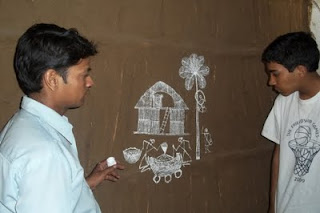By Chaitanya Bhat
The Project: Part 1
The Project: Part 1
I feel that the whole day is an experience so I will share all of it. I have traveled to India for my artisan practicum. I will be working with an artisan who specializes in Warli paintings. Today, we left my uncle's house at about 8 in the morning and then because of our compulsion to always forget something, we had to go back to my uncle's house to get it. We got to the place where we were staying for the week and met the artisan and the person who would be our photographer. Then we went to a village to learn about the history of Warli painting. There we met a painter who talked about his work. We spent the next day at his village with the villagers and learned a little bit about their culture. I learned the basics of Warli painting and got to witness an amazing tribal dance.
Here I am (left) in the village.
My mother, who traveled with me, is on the far right.
Here I am pointing at a Warli painting.
The Project: Part 2
Today I asked the artisan a few questions about what he does.
How did the word Warli come about? The word Warli came about this way. During the reign Chatrapati Shivaji, there was a war. Many communities lost their men-folk, leaving behind widows and orphans. These survivors of the deceased (warle-dead) became to be known as the warli community, confined largely to the tribal areas of Gujrat and Maharasthra. These communities are not far from Mumbai- the Urbs Prima. The paradox could not be more glaring between Mumbai and the communities.
How did the word Warli come about? The word Warli came about this way. During the reign Chatrapati Shivaji, there was a war. Many communities lost their men-folk, leaving behind widows and orphans. These survivors of the deceased (warle-dead) became to be known as the warli community, confined largely to the tribal areas of Gujrat and Maharasthra. These communities are not far from Mumbai- the Urbs Prima. The paradox could not be more glaring between Mumbai and the communities.


How did the painting originate and how did it get the name of Warli? The poor simple tribals built their homes with the natural materials abundantly available in the forest. Reeds of the karvi plants and residual stalks of grain were used. They were tied together by the bark of trees or creepers as ropes. This screen was plastered with cow dung and mud to create the walls of the house. On festive occasions these people felt like decorating these walls, but they had no access to pigments, colors, paints and brushes so they did the obvious. They used a paste of rice flour (staple food) as a paint and bamboo sticks as brushes and began painting simple motifs of village life-birds, animals, activities, festivals, rituals, the cycle of birth, life and death, the cycle of seasons and the farming cycles. The effect is stunning. You can't imagine the stark contrast and how the painting works with the background when you see a dark brown or red surface, in dark interiors, with white figures on it. It's really amazing.
They depicted the human figures using triangles (for the body), circles (for the head) and lines (for the arms, legs and actions.). These were all drawn freehand, no rulers or compasses required. The artist doesn't even sketch an outline first. He just dips the bamboo stick into the rice paste and draws on the wall. Urban India began to take notice of this traditional art form, resulting in a steady influx of students, researchers and artists flocking to these villages to learn, research and document their work. About half a century ago, Shri Jiva Soma Mhase was confronted with the question, "what is the name of this art?" and his spontaneous, obvious response was "Warli," since it originates from the Warli tribe and is an inextricable part of the community. The advent of television and media earned him recognition and many awards. Last year, the Indian government honored him with a Padma Shri. His efforts convinced a lot of other artists to take up this painting as a livelihood. This led to the commercialization of the art form. These artists have travelled far and wide in India and abroad, painting and teaching as they go. These Warli paintings decorate many a home and offices of the elite all over the world.
They depicted the human figures using triangles (for the body), circles (for the head) and lines (for the arms, legs and actions.). These were all drawn freehand, no rulers or compasses required. The artist doesn't even sketch an outline first. He just dips the bamboo stick into the rice paste and draws on the wall. Urban India began to take notice of this traditional art form, resulting in a steady influx of students, researchers and artists flocking to these villages to learn, research and document their work. About half a century ago, Shri Jiva Soma Mhase was confronted with the question, "what is the name of this art?" and his spontaneous, obvious response was "Warli," since it originates from the Warli tribe and is an inextricable part of the community. The advent of television and media earned him recognition and many awards. Last year, the Indian government honored him with a Padma Shri. His efforts convinced a lot of other artists to take up this painting as a livelihood. This led to the commercialization of the art form. These artists have travelled far and wide in India and abroad, painting and teaching as they go. These Warli paintings decorate many a home and offices of the elite all over the world.







No comments:
Post a Comment